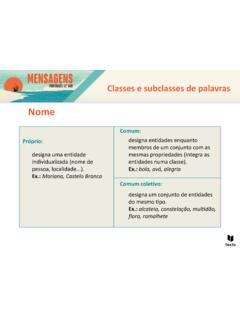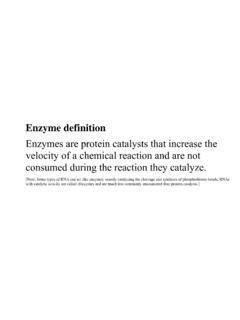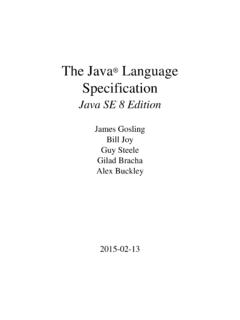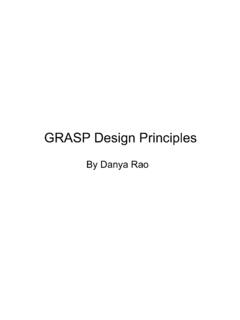Transcription of Ontology Development 101: A Guide to Creating ... - Protégé
1 1 Ontology Development 101: A Guide to Creating YourFirst OntologyNatalya F. Noy and Deborah L. McGuinnessStanford University, Stanford, CA, and Why develop an Ontology ?In recent years the Development of ontologies explicit formal specifications of the terms inthe domain and relations among them (Gruber 1993) has been moving from the realm ofArtificial-Intelligence laboratories to the desktops of domain experts. Ontologies havebecome common on the World-Wide Web. The ontologies on the Web range from largetaxonomies categorizing Web sites (such as on Yahoo!) to categorizations of products forsale and their features (such as on ). The WWW Consortium (W3C) isdeveloping the Resource Description Framework (Brickley and Guha 1999), a language forencoding knowledge on Web pages to make it understandable to electronic agents searchingfor information.
2 The Defense Advanced Research Projects Agency (DARPA), inconjunction with the W3C, is developing DARPA Agent Markup Language (DAML) byextending RDF with more expressive constructs aimed at facilitating agent interaction on theWeb (Hendler and McGuinness 2000). Many disciplines now develop standardized ontologiesthat domain experts can use to share and annotate information in their fields. Medicine, forexample, has produced large, standardized, structured vocabularies such as SNOMED (Price andSpackman 2000) and the semantic network of the Unified Medical Language System(Humphreys and Lindberg 1993). Broad general-purpose ontologies are emerging as well. Forexample, the United Nations Development Program and Dun & Bradstreet combined theirefforts to develop the UNSPSC Ontology which provides terminology for products andservices ( ).An Ontology defines a common vocabulary for researchers who need to share information ina domain.
3 It includes machine-interpretable definitions of basic concepts in the domain andrelations among would someone want to develop an Ontology ? Some of the reasons are: To share common understanding of the structure of information among people orsoftware agents To enable reuse of domain knowledge To make domain assumptions explicit To separate domain knowledge from the operational knowledge To analyze domain knowledgeSharing common understanding of the structure of information among people or softwareagents is one of the more common goals in developing ontologies (Musen 1992; Gruber1993). For example, suppose several different Web sites contain medical information orprovide medical e-commerce services. If these Web sites share and publish the sameunderlying Ontology of the terms they all use, then computer agents can extract andaggregate information from these different sites.
4 The agents can use this aggregatedinformation to answer user queries or as input data to other reuse of domain knowledge was one of the driving forces behind recent surge inontology research. For example, models for many different domains need to represent thenotion of time. This representation includes the notions of time intervals, points in time,relative measures of time, and so on. If one group of researchers develops such an ontologyin detail, others can simply reuse it for their domains. Additionally, if we need to build a large2ontology, we can integrate several existing ontologies describing portions of the largedomain. We can also reuse a general Ontology , such as the UNSPSC Ontology , and extend itto describe our domain of explicit domain assumptions underlying an implementation makes it possible tochange these assumptions easily if our knowledge about the domain changes.
5 Hard-codingassumptions about the world in programming-language code makes these assumptions notonly hard to find and understand but also hard to change, in particular for someone withoutprogramming expertise. In addition, explicit specifications of domain knowledge are usefulfor new users who must learn what terms in the domain mean. Separating the domain knowledge from the operational knowledge is another common useof ontologies. We can describe a task of configuring a product from its components accordingto a required specification and implement a program that does this configuration independentof the products and components themselves (McGuinness and Wright 1998). We can thendevelop an Ontology of PC-components and characteristics and apply the algorithm toconfigure made-to-order PCs. We can also use the same algorithm to configure elevators ifwe feed an elevator component Ontology to it (Rothenfluh et al.)
6 1996).Analyzing domain knowledge is possible once a declarative specification of the terms isavailable. Formal analysis of terms is extremely valuable when both attempting to reuseexisting ontologies and extending them (McGuinness et al. 2000).Often an Ontology of the domain is not a goal in itself. Developing an Ontology is akin todefining a set of data and their structure for other programs to use. Problem-solving methods,domain-independent applications, and software agents use ontologies and knowledge basesbuilt from ontologies as data. For example, in this paper we develop an Ontology of wine andfood and appropriate combinations of wine with meals. This Ontology can then be used as abasis for some applications in a suite of restaurant-managing tools: One application couldcreate wine suggestions for the menu of the day or answer queries of waiters and application could analyze an inventory list of a wine cellar and suggest which winecategories to expand and which particular wines to purchase for upcoming menus this guideWe build on our experience using Prot g -2000 (Protege 2000), Ontolingua (Ontolingua1997), and Chimaera (Chimaera 2000) as Ontology -editing environments.
7 In this Guide , weuse Prot g -2000 for our wine and food example that we use throughout this Guide is loosely based on an exampleknowledge base presented in a paper describing CLASSIC a knowledge-representationsystem based on a description-logics approach (Brachman et al. 1991). The CLASSIC tutorial(McGuinness et al. 1994) has developed this example further. Prot g -2000 and otherframe-based systems describe ontologies declaratively, stating explicitly what the classhierarchy is and to which classes individuals Ontology -design ideas in this Guide originated from the literature on object-orienteddesign (Rumbaugh et al. 1991; Booch et al. 1997). However, Ontology Development isdifferent from designing classes and relations in object-oriented programming. Object-oriented programming centers primarily around methods on classes a programmer makesdesign decisions based on the operational properties of a class, whereas an Ontology designermakes these decisions based on the structural properties of a class.
8 As a result, a classstructure and relations among classes in an Ontology are different from the structure for asimilar domain in an object-oriented is impossible to cover all the issues that an Ontology developer may need to grapple withand we are not trying to address all of them in this Guide . Instead, we try to provide a startingpoint; an initial Guide that would help a new Ontology designer to develop ontologies. At the3end, we suggest places to look for explanations of more complicated structures and designmechanisms if the domain requires , there is no single correct Ontology -design methodology and we did not attempt todefine one. The ideas that we present here are the ones that we found useful in our ownontology- Development experience. At the end of this Guide we suggest a list of references foralternative What is in an Ontology ?
9 The Artificial-Intelligence literature contains many definitions of an Ontology ; many ofthese contradict one another. For the purposes of this Guide an Ontology is a formal explicitdescription of concepts in a domain of discourse (classes (sometimes called concepts)),properties of each concept describing various features and attributes of the concept (slots(sometimes called roles or properties)), and restrictions on slots (facets (sometimes calledrole restrictions)). An Ontology together with a set of individual instances of classesconstitutes a knowledge base. In reality, there is a fine line where the Ontology ends andthe knowledge base are the focus of most ontologies. Classes describe concepts in the domain. Forexample, a class of wines represents all wines. Specific wines are instances of this class. TheBordeaux wine in the glass in front of you while you read this document is an instance of theclass of Bordeaux wines.
10 A class can have subclasses that represent concepts that are morespecific than the superclass. For example, we can divide the class of all wines into red, white,and ros wines. Alternatively, we can divide a class of all wines into sparkling and non-sparkling wines. Slots describe properties of classes and instances: Ch teau Lafite RothschildPauillac wine has a full body; it is produced by the Ch teau Lafite Rothschildwinery. We have two slots describing the wine in this example: the slot body with the valuefull and the slot maker with the value Ch teau Lafite Rothschild winery. At theclass level, we can say that instances of the class Wine will have slots describing theirflavor, body, sugar level, the maker of the wine and so instances of the class Wine, and its subclass Pauillac, have a slot maker the value ofwhich is an instance of the class Winery (Figure 1).








